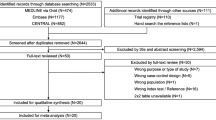Abstract
Introduction
Several studies have recently questioned whether routine radiographic screening for pelvic fractures is necessary in the initial evaluation of blunt trauma patients. Therefore, we assessed how sensitive and specific the clinical examination is in detecting fractures of the pelvis.
Methods
We extensively searched various medical databases for studies that reported on the accuracy of pelvic examination in severely injured adults or children. Individual study results were summarized in a receiver operating characteristics (ROC) curve and pooled in a meta-analysis.
Results
Twelve studies with a total of 5454 patients met our inclusion criteria and provided data in sufficient detail. Pooled sensitivity and specificity were 0.90 (95% confidence interval: 0.85–0.93) and 0.90 (0.84–0.94), respectively. Results were better in those studies which excluded neurologically impaired patients [e.g., Glasgow Coma Scale (GCS) <13]. Among the 49 false negative cases whose fractures went undetected on clinical examination, the majority of patients had either altered consciousness or minor pelvic fracture only. Only 3 clinically relevant pelvic fractures were missed among 441 patients with fracture within a total population of 5235 patients.
Conclusion
In stable and alert trauma patients, a thorough clinical examination will detect pelvic fractures with nearly 100% sensitivity, thus rendering initial radiography unnecessary in this group of patients.

Similar content being viewed by others
References
Begg CB (1987) Biases in the assessment of diagnostic tests. Stat Med 6:411–423
Civil ID, Ross SE, Botehlo G, Schwab CW (1988) Routine pelvic radiography in severe blunt trauma: is it necessary? Ann Emerg Med 17:488–490
Demetriades D, Karaiskakis M, Toutouzas K, Alo K, Velmahos G, Chan L (2002) Pelvic fractures: epidemiology and predictors of associated abdominal injuries and outcomes. J Am Coll Surg 195:1–10
Duane TM, Cole FJ, Jr., Weireter LJ Jr, Britt LD (2001) Blunt trauma and the role of routine pelvic radiographs. Am Surg 67:849–853
Duane TM, Tan BB, Golay D, Cole FJ Jr, Weireter LJ Jr, Britt LD (2002) Blunt trauma and the role of routine pelvic radiographs: a prospective analysis. J Trauma 53:463–468
Gillott A, Rhodes M, Lucke J (1988) Utility of routine pelvic X-ray during blunt trauma resuscitation. J Trauma 28:1570–1574
Gonzalez RP, Fried PQ, Bukhalo M (2002) The utility of clinical examination in screening for pelvic fractures in blunt trauma. J Am Coll Surg 194:121–125
Grant PT (1990) The diagnosis of pelvic fractures by ‘springing’. Arch Emerg Med 7:178–182
Guillamondegui OD, Pryor JP, Gracias VH, Gupta R, Reilly PM, Schwab CW (2002) Pelvic radiography in blunt trauma resuscitation: a diminishing role. J Trauma 53:1043–1047
Ham SJ, van Walsum ADP, Vierhout PAM (1996) Predictive value of the hip flexion test for fractures of the pelvis. Injury 27:543–544
Heath FR, Blum F, Rockwell S (1997) Physical examination as a screening test for pelvic fractures in blunt trauma patients. W V Med J 93:267–269
John SD, Moorthy C, Swischuk LE (1996) The value of routine cervical spine, chest, and pelvis radiographs in children after trauma. Emerg Radiol 3/4:178–180
Junkins EP Jr, Furnival RA, Bolte RG (2001) The clinical presentation of pediatric pelvic fractures. Pediatr Emerg Care 17:15–18
Junkins EP Jr, Nelson DS, Carroll KL, Hansen K, Furnival RA (2001) A prospective evaluation of the clinical presentation of pediatric pelvic fractures. J Trauma 51:64–68
Kaneriya PP, Schweitzer ME, Spettell C, Cohen MJ, Karasick D (1999) The cost-effectiveness of routine pelvic radiography in the evaluation of blunt trauma patients. Skeletal Radiol 28:271–273
Koury HI, Peschiera JL, Welling RE (1993) Selective use of pelvic roentgenograms in blunt trauma patients. J Trauma 34:236–237
Moses LE, Shapiro D, Littenberg B (1993) Combining independent studies of a diagnostic test into a summary ROC curve: data-analytic approaches and some additional considerations. Stat Med 12:1293–1316
Niedens BA, Gross EA (2003) Validation of a decision instrument to limit pelvic radiography in blunt trauma (abstract). Acad Emerg Med 10:475–476
Pehle B, Nast-Kolb D, Oberbeck R, Waydhas C, Ruchholtz S (2003) Wertigkeit der körperlichen und radiologischen Basisdiagnostik des Beckens in der Schockraumbehandlung. Unfallchirurg 106:642–648
Pehle B, Richard J, Waydhas C, Nast-Kolb D, Ruchholtz S. (2003) Wertigkeit der körperlichen und radiologischen Basisdiagnostik des Beckens in der Schockraumbehandlung (abstract). In: Haas NP (ed) Abstract CD zum 120. Kongress der Deutschen Gesellschaft für Chirurgie. Deutsche Gesellschaft für Chirurgie, Berlin
Rees MJ, Aickin R, Kolbe A, Teele RL (2001) The screening pelvic radiograph in pediatric trauma. Pediatr Radiol 31:497–500
Salvino CK, Esposito TJ, Smith D, Dries D, Marshall W, Flisak M, Gamelli RL (1992) Routine pelvic X-ray studies in awake blunt trauma patients: a sensible policy? J Trauma 33:413–416
Tien IY, Dufel SE (2000) Does ethanol affect the reliability of pelvic bone examination in blunt trauma? Ann Emerg Med 36:451–455
Yugueros P, Sarmiento JM, Garcia AF, Ferrada R (1995) Unnecessary use of pelvic X-ray in blunt trauma. J Trauma 39:722–725
Author information
Authors and Affiliations
Corresponding author
Additional information
Supported in part by Deutsche Forschungsgemeinschaft (Grant SA 862/1–1)
Rights and permissions
About this article
Cite this article
Sauerland, S., Bouillon, B., Rixen, D. et al. The reliability of clinical examination in detecting pelvic fractures in blunt trauma patients: a meta-analysis. Arch Orthop Trauma Surg 124, 123–128 (2004). https://doi.org/10.1007/s00402-003-0631-8
Received:
Published:
Issue Date:
DOI: https://doi.org/10.1007/s00402-003-0631-8




